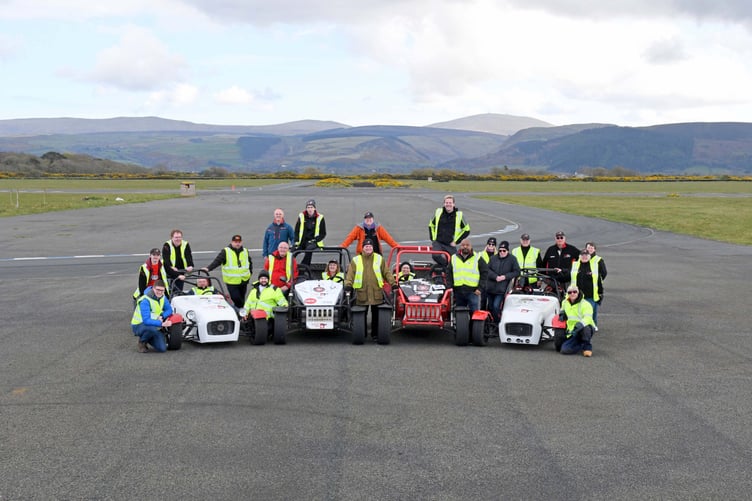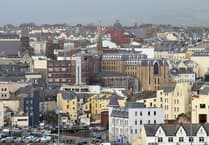This week, I had the opportunity to drive for the first time in nine years.
I started to learn to drive when I was 16, but six months later I became visually impaired.
It won’t come as a surprise that shortly after I had to stop driving.
Bolton-based charity Speed of Sight came to the island to offer a driving experience for up to 50 individuals who can’t drive due to a disability.
The two-day event took place at Jurby Airfield, allowing participants to drive in a safe environment.
The cars were adapted, so there were two steering wheels and two sets of pedals.
I was in the car with an instructor and we both had radio links in our helmets so we could communicate.
For the first lap, my instructor, Tina Cassady, drove and showed me the straightforward controls, which were an accelerator pedal, a brake pedal and the steering wheel.
She gradually relinquished control and would tell me to go left or right or to step off the accelerator.
My visual impairment affects my central vision. I have 20/200 vision which means what someone with 20/20 vision can see from 200 feet, I can see from 20 feet.
I was told afterwards that I was easily hitting 90 miles an hour.
With that kind of speed, I noticed how late I could see the turns or chicane, so having the instructor patiently telling me when to start turning, was what enabled me to drive without crashing.
While driving, I asked my instructor if she ever got scared of having a visually-impaired person at the wheel.
She told me that her day job is a driving instructor and she gets more scared with some of the sighted students that she takes out. After the drive, she laughed at my question with another driving instructor, Stuart Taylor, who agreed with what she said.
Stuart explained: ‘Somebody who has got vision has an idea of what they want to do and what they think is correct, so they are more likely to be unpredictable because that is what they think is the right thing to do.
‘When it’s somebody who is driving who has got sight loss, there is the trust there. They tend to react to what you say, so once you know how long they are going to take to react, it can be more predictable.’
I loved the experience. For me it was great to be able to control a car again and go as fast as I could.
For others it meant much more.
One of the volunteers told me that someone who was driving in the morning was in intensive care six weeks ago, and was able to drive this week.
That individual was blown away by what the charity does.
Phil Collins, one of the volunteers, said: ‘It is really nice when people get out of the car and they think “I can do stuff”.
‘Especially for those with disabilities, they are told that they can’t do stuff all the time, so it is great to see some people come out of the car, and they realise “I can do this, what else can I do?”’
John Williams, who went driving just after me, said that it was his first time driving in his life as he was born partially sighted. He is in his 60s. He said: ‘Beforehand, I didn’t know what to expect and I thought I was going to enjoy it, and I did. I more than enjoyed it, it was fantastic.’
The charity was co-founded by Mike Newman and John Galloway.
Mike, who was born without any sight, had always had a dream of being a racing car driver.
He has since broken eight world records for the fastest blind man, including taking a car over 200 miles per hour, a motorbike record, and doing a loop de loop in a plane.
It was after some of these records that he set up the charity as he wanted to give that thrill to others.
He said: ‘After getting some notoriety from the two records that I had at the time, I went to various car events, and spoke to people who had become disabled in adult life, and as a consequence they had to relinquish their driving licence.
‘The thing they missed most was that they couldn’t drive anymore. That was a constant message from the people I was talking to.
‘So I started thinking about how I could give them back that exhilaration behind the wheel. If I can do it for myself, how can I do it for other people?
‘I came up with a concept that I thought would work and eventually I spoke to my friend John who co-founded the charity with me.’
John said: ‘In 2012, we gave up our day jobs and Speed of Sight was born. Since then, around 2,500 people of all ages and all backgrounds have done what we are doing here today.’
Mike added: ‘The radio link that you experienced today is vital so we want communication with the instructor, we want to ensure that the participants are driving themselves, working as a team with an instructor.
John continued: ‘Different people will drive at different paces, so what we don’t want to be is a charity that drives people around.
‘We have no passengers, each individual drives these cars, and that for the individuals is really special, and they are not scaring themselves to death.
‘If they are capable because the instructor feels they can go from 80 to 110 miles an hour then we will go there. We want to drive within everyone’s means.’
The cars go up to 120 miles per hour, and have regular car engines.
John said: ‘One of the cars has a BMW 1800 engine, another one has a Mazda MX5 engine, and the other has a two-litre Honda engine and these have all been put into cars with no real weights, they have no car doors or windows, so essentially they are flipping quick.’
Speed of Sight had 20 volunteers travel with them.
The charity was invited to the island by the British Irish Trading Alliance, which works across the British Isles to bring businesses together and help with sponsorship.
Jennie Thompson, director of the Isle of Man branch, said: ‘We do events which promote the island and through facilitation, we help both businesses and charities.’
As well as the event providing the opportunity for Sight Matters members to take part, it also helped raise money for the local sight loss charity.
Cathryn Bradley, chief executive officer of Sight Matters, said: ‘It has been a roaring success.
‘A picture paints 1,000 words, and seeing the smiles on people’s faces, the nervousness for some when they start, and then they come back and have a massive smile.’
She added: ‘We had people who have driven and had to stop driving and people who have never driven.
‘As a driver, it is something that we take for granted the freedom that it brings, so for someone who has never had that experience that must have been fantastic.’
John Galloway said that the charity would love to come back to the island, if it is invited, with the hope that it could become an annual event, to provide more island residents who usually can’t, the opportunity to drive.


-(1).jpeg?width=209&height=140&crop=209:145,smart&quality=75)
.png?width=209&height=140&crop=209:145,smart&quality=75)
.jpg?width=209&height=140&crop=209:145,smart&quality=75)
Comments
This article has no comments yet. Be the first to leave a comment.